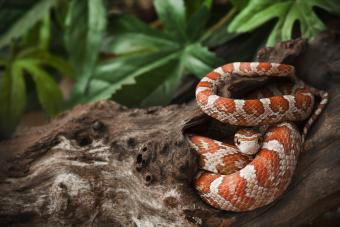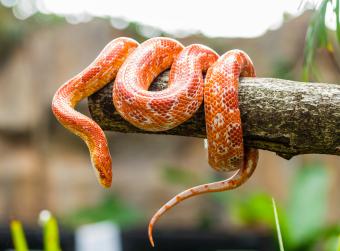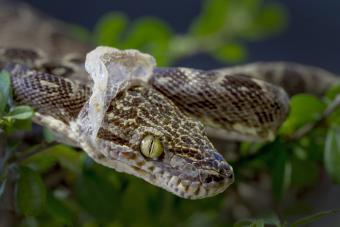
Corn snakes are very popular pets, but surprisingly few new owners know how large they can get. The good news is, corn snakes are not giants. How big your snake will grow depends on several factors, including their sex, diet, tank size, and temperature. Make sure your pet is growing appropriately by comparing their age and size to our corn snake growth chart.
How Big Do Corn Snakes Get?
Most corn snakes grow to be between 3 and 5 feet long and weigh about 1 to 2 pounds. Some exceptional corn snakes can reach 6 feet. Males are normally longer and larger than females when they reach adulthood, but this isn't always a reliable way to tell the sexes apart.
Hatchlings begin between 8 and 12 inches long when they emerge from their eggs, and gradually increase in size. Corn snakes grow gradually, so don't expect to see any big growth spurts. They usually reach their full size by the time they're 2 to 3 years old.
Corn Snake Growth Chart by Age
Track your corn snake's growth or estimate their age using this chart.
| Life Stage (Age) | Length |
| Hatchling (0-6 months) | 8 to 15 inches |
| Juvenile (6-12 months) | 15 to 30 inches |
| Young Adult (1-2 years) | 30 to 40 inches |
| Adult (2-3 years) | 40 to 60 inches |
Measuring your corn snake is easy. Just take a string, and starting at the tail, run the string along your corn snake's body while you are handling it. Then, mark your snake's length and check it with a measuring tape.
Factors That Impact Size
Genetics can play a role in how big your corn snake will get, but there are a few other factors that can impact their final size. Be mindful of your snake's care requirements to make sure they grow to their proper size.

Habitat
Your corn snake's environment can significantly impact how big they get. Make sure you pick an appropriate tank based on your pet's age and upgrade it as they grow. A 10-gallon tank is fine for a hatchling or baby, but an adult corn snake needs at least a 40-gallon enclosure. Remember; bigger is always better.
Snakes do not stop growing to fit their enclosure. If they don't have enough room, you can stunt their growth, which is unhealthy and can lead to problems later.
Diet
Without the right nutrients, your corn snake won't grow properly. Adults should get thawed mice - up to three at a time - every 10 to 14 days, whereas hatchlings need to eat more frequently, typically weekly. Feed hatchlings a single, small mouse. Pick a mouse that's the same thickness as your corn snake's midsection. You can feed rats and other rodents occasionally - and even a quail egg, once in a while - but stick with mice as your snake's staple diet.
Feeding snakes who refuse to eat may require that you use tongs to simulate prey movement with thawed mice. Hold mice by their tails and move them around slightly to stimulate your snake's prey drive. If your corn snake prefers live prey, consider offering pinky mice. Do not handle your snake for at least 48 hours after they've eaten. Otherwise, they may regurgitate their meal.
Temperature
Temperature can affect your corn snake's size. If their habitat is too warm, they can overheat. However, they can't digest their food properly if it's too cool. Corn snakes need an ambient temperature between 78 and 82 degrees Fahrenheit, a cool area of around 75 degrees, and a warm basking area of 90 degrees.
When they are fully grown, corn snakes are relatively docile if you handle them properly throughout their life. Snakes need enrichment and socialization to adjust properly to human handling, just like most other pets.
Full Grown Corn Snake Size
Corn snakes are long, slender reptiles that can make excellent pets. But before you get a corn snake, make sure you're prepared for their full-grown size and have room for an appropriately sized tank. Without the right environment, temperature, and diet, your snake may have growth defects, so provide them with the best care you can to ensure they live a healthy life.







